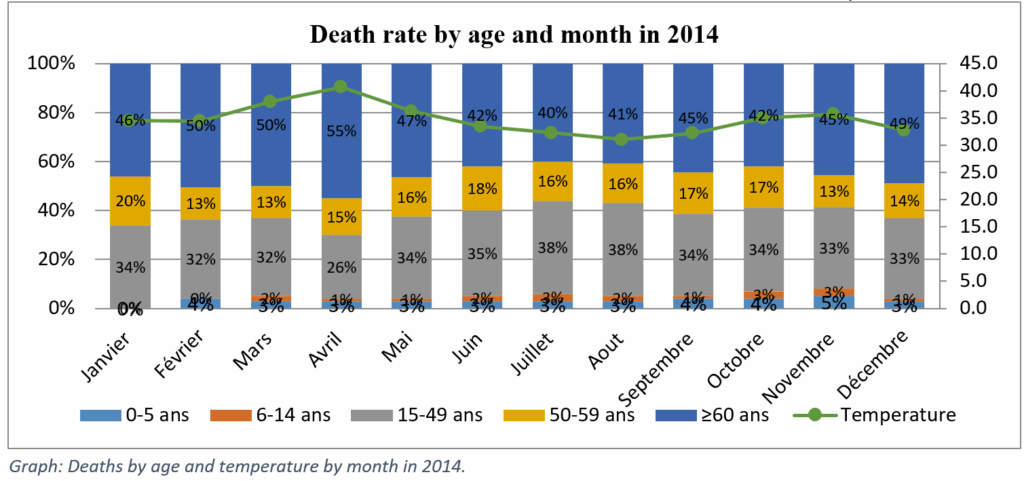By Hippolyte Traoré, Public Health Researcher, National Institute of Public Health (NIPH), Mali[1]
Introduction
In Mali, the months of March, April and May each year are periods of high heat. The aim of the study was to describe the evolution of deaths among the elderly (aged 60 and over) in Bamako during heatwaves from 2013 to 2016.
Methods
This was a cross-sectional, descriptive study of people over 60 years of age who died and were registered by the Bamako Central Office for the Registration of Deaths and the Issuance of Burial Permits. Temperature data from “Mali-Météo” were used.
Results
Of a total of 11913 deaths recorded, 56% were male. Older people were the most numerous (46.1%), followed by 15-49 year-olds (32.8%).
- Age-specific death rates by temperature per month in 2013: In 2013, the average maximum (40.6°C) and minimum (25.9°C) extreme temperatures were observed in order of importance in March, April and May. The highest death rate (45%) was among the elderly, compared with other age groups.
- Age-specific death rates by temperature per month in 2014: Analysis of the above graph shows that the average extreme temperatures in 2014 (maximum 40.6°C and minimum 25.5°C) were observed in order of importance in April, March and May. The highest death rate (55%) was among the elderly, compared with other age groups.
- Death rates by age and temperature by month in 2015: In 2015, extreme temperatures (maximum 39.9°C and minimum 25.6°C) were observed in order of importance in April, March and May. The highest death rate (51%) was among the elderly, compared with other age groups.
- Death rates by age and temperature by month in 2016: In 2016, extreme temperatures (maximum 40.9°C and minimum 26.6°C) were observed in order of importance in April, March and May, with a high death rate (57%) among the elderly compared with rates for other age groups.
- Impact of the heatwave on the vulnerability of the elderly: The diagnoses of death were mostly poorly stated or non-existent in the registers, due to poor record-keeping. The diagnoses recorded were hypertension, cardio-respiratory problems, diabetes and death on arrival. Vulnerability to the heatwave, combined with the above-mentioned pathologies, is thought to be at the root of the high death rates (excess mortality) among the elderly. The study noted peaks in elderly deaths not attributable to the heatwave, which occurred in January-February (cold season with winds), June (beginning of rainy period), October-November (end of rainy season), when temperatures vary between 34°C-35°C, mainly caused by respiratory diseases and malaria.
Conclusion
In view of these results, health authorities need to computerise death registers, adopt preventive measures such as informing the elderly in nursing homes and mobilising additional resources for their holistic care. As part of the “One Health” platform, meteorological services must regularly communicate their timely data to sentinel sites and emergency services in other sectors, through the creation of an early warning network at central and decentralised levels.
[1] Bakary Diarra, University of Sciences; Niakalé Diawara, Bintou Fomba, Aly Landouré, and Mamadou Souncalo TRAORE, NIPH.

Disclaimer: The views expressed in this piece are those of the author/s and do not necessarily reflect the views or policies of AIDMI.
